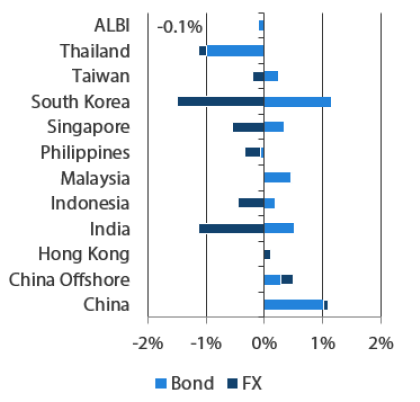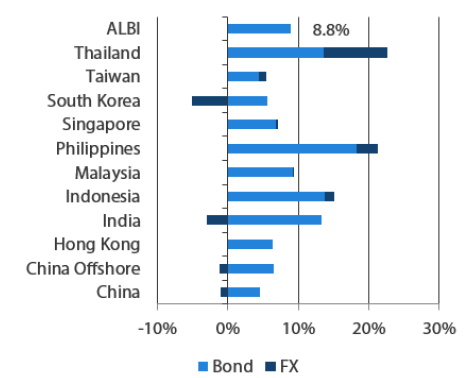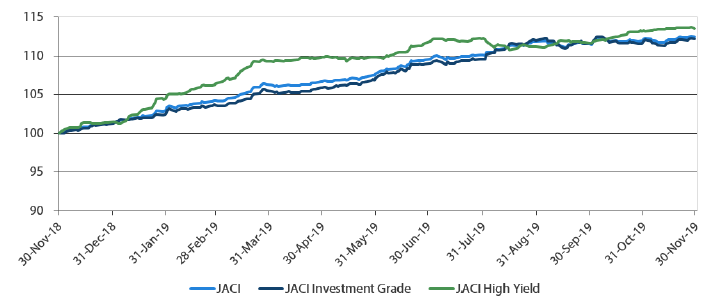Summary
- US Treasury (UST) yields rose early in November, driven by optimism on the trade front. Risk aversion heightened towards the month-end on concerns that a newly legislated US law backing the pro-democracy protesters in Hong Kong could complicate US-China trade negotiations. Overall, UST yields traded higher, with 10-year yields ending the month at 1.77%.
- Asian credits returned 0.28% in November, mainly due to credit spreads tightening by about 4 basis points (bps) on the month. High-grade (HG) and high-yield (HY) credits were roughly similar in performance. HG credits gained 0.28%, with spreads tightening 4.5 bps, while HY credits returned 0.29%, with spreads tightening about 5 bps.
- Within the region, the Bank of Thailand (BOT) cut its policy rate by 25 bps to a record low of 1.25% in November, while Bank Negara Malaysia (BNM) kept its Overnight Policy Rate (OPR) unchanged at 3.00%. Third quarter GDP prints were mixed across Asia, with an upside surprise from the Philippines, which reported one of the strongest 3Q growths in the region of 6.2% year-on-year (YoY).
- Issuance picked up pace in November as pre-funding continued ahead of the year-end. The HG space saw 34 new issues amounting to about USD 19.0 billion, while the HY space had 39 new issues totalling roughly USD 10.5 billion.
- We expect Asian currencies to remain volatile, driven by trade uncertainty. We favour Malaysian and Indonesian bonds due to their attractive yields and expect them to outperform other bond markets. We are neutral to slightly cautious on low-yielding and trade-sensitive countries.
- As for Asian credit, we expect spreads and UST yields to remain range-bound for the time being, with a bias towards slightly tighter spreads and higher rates with returns mainly coming from carry. The outcome of US-China trade negotiations remains a crucial factor.
Asian Rates and FX
Market Review
Risk sentiment mixed in November, UST yields higher
The ebb and flow of US-China trade talks and prospects of the two countries reaching a "Phase One" trade deal continued to dictate market sentiment, which was mostly positive in the first few weeks of November. Risk aversion, however, heightened at the end of the month on concerns that a newly legislated US law backing pro-democracy protesters in Hong Kong could complicate US-China trade negotiations. US economic data released in November was mixed overall, and US Federal Reserve (Fed) officials reiterated that they are likely to stick to an appropriate monetary policy stance, barring developments that would prompt them to re-assess their favourable baseline outlook for the US economy. The UST yield curve sold off slightly, with 10-year yields rising about 8 bps to end at 1.77% from 1.69% at the end of October. Yields of 2-year USTs also ended the month about 9 bps higher from the prior month.
Markit iBoxx Asian Local Bond Index (ALBI)
For the month ending 30 November 2019

For the year ending 30 November 2019

Source: Markit iBoxx Asian Local Currency Bond Indices, Bloomberg, 30 November 2019
Note: Bond returns refer to ALBI indices quoted in local currencies while FX refers to local currency movement against USD. ALBI regional index is in USD unhedged terms. Returns are based on historical prices. Past performance is not necessarily indicative of future performance.
BOT cuts policy rate
In November, the BOT cut its policy rate by 25 bps to a record low of 1.25% as expected. The monetary policy committee voted 5-2 for the second cut of the year, citing lacklustre growth and negative impact from the strong Thai baht which weighed on the economy. In addition, the central bank announced some easing of FX rules in a bid to arrest the baht’s appreciation.
BNM leaves policy rates unchanged but reduces Statutory Reserve Requirement (SRR) ratio
BNM kept the OPR unchanged at 3.00% in November and maintained its 2019 growth projection of 4.3–4.8%. Later in the month, however, the central bank cut the SRR ratio by 50 bps to 3.00% to inject liquidity into the system. The SRR ratio determines the required balances that banking institutions have to maintain in their Statutory Reserve Accounts as a share of their eligible liabilities.
Third quarter GDP prints mixed across Asia, upside surprise from the Philippines
A string of ASEAN economies released their 3Q 2019 GDP figures in November. The Philippines posted one of the strongest growths in the region; its GDP increased 6.2% YoY in 3Q from 5.5% in 2Q, boosted by a rebound in investments and consumption. Thailand reported growth of 2.4% YoY in 3Q from 2.3% in 2Q as government spending and investment growth picked up. Malaysia's 3Q GDP moderated to 4.4% YoY from 4.9% in 2Q on weak investment and slightly softer consumption. Indonesia’s 3Q GDP eased slightly to 5.02% YoY from 5.05% in 2Q as domestic demand weakened slightly. Singapore saw its GDP growth improve to 0.5% in 3Q from 0.2% in 2Q, as its manufacturing sector contracted less relative to the prior month. Lastly, India's GDP growth decelerated to about 4.5% YoY in the July-September period from 5% in the previous period as investment growth eased despite signs of a modest recovery in consumption.
Market Outlook
Trade talks to dictate near term direction of Asian currencies, longer term outlook mildly bullish
We expect Asian currencies to remain volatile, driven by uncertainty over trade talks. Trade sensitive currencies such as the Renminbi and the South Korean won, in particular, will remain subject to market swings in the near term. In the longer term, we think that inflows into Asia will resume and support the region’s currencies as we see global growth recovering next year and the Fed putting monetary policy on hold for a period of time.
Attractive real yielders such as Indonesian and Malaysian bonds expected to outperform
Within the Asian bond market, we favour Malaysian and Indonesian bonds due to their attractive yields and expect them to outperform other bond markets. We are neutral to slightly cautious on low-yielding and trade sensitive countries. We expect global growth to recover next year, with low-yielding bond yields to either trade in range or slowly grind higher.
Asian Credits
Market Review
Asian credit spreads tighten, trade developments remain the key driver
Asian credits returned 0.28% in November, mainly due to credit spreads tightening by about 4 bps on the month. HG and HY credits delivered roughly similar performance. HG credits gained 0.28%, with spreads tightening 4.5 bps, while HY credits returned 0.29%, with spreads tightening about 5 bps.
US-China trade negotiations remain the key driver of spreads in Asia. A positive tone earlier in the month caused spreads to tighten significantly earlier in November. However, towards mid-November, emerging news flow suggesting that negotiations towards an initial “Phase One” trade deal remained at an impasse reversed sentiment and prompted credit spreads to widen. The two sides currently remain engaged in talks and the lull in the trade spat is likely to continue through early next year; that said, the tail risk on this front has certainly grown, in our view. Caution also prevailed in November after US President Donald Trump signed into law a legislation backing pro-democracy protesters in Hong Kong. Amid the mixed developments on trade, China reported a set of weak economic data for October, including industrial production, fixed asset investment and retail sales. China subsequently reduced certain policy rates by 5 bps and relaxed capital requirements for some infrastructure projects to support the domestic economy. These developments further weighed on spreads in the second half of November but were ultimately of secondary importance to trade talks. Elsewhere, Moody’s lowered the outlook on India’s Baa2 sovereign rating to negative from stable in early November, due to concerns on slowing growth and rising risk of fiscal slippage. Indian credit spreads widened modestly after the rating action. Meanwhile, the socio-political unrest in Hong Kong escalated further during the month, although the negative impact on Hong Kong credit spreads remained modest.
Primary market activity picks up momentum
New Asian credit issuance picked up pace in November as pre-funding continued ahead of the year’s end. The HG space saw 34 new issues amounting to about USD 19.0 billion, including a USD 6 billion multi-tranche China sovereign bond issue. Meanwhile, the HY space had 39 new issues totalling about USD 10.5 billion.
JP Morgan Asia Credit Index (JACI)
Index rebased to 100 at 30 November 2018

Note: Returns in USD. Past performance is not necessarily indicative of future performance. Source: JP Morgan, 30 November 2019
Market Outlook
Credit spreads to stay range-bound, US-China trade talk outcome remains crucial
We expect Asian credit spreads and UST yields to remain range-bound for the time being, with a bias towards slightly tighter spreads and higher rates, and returns mainly coming from carry. Credits with strong management and a track record of operating through tough business and funding environments are likely to outperform. Within China HY, we have a preference for short-dated property bonds over industrial bonds. Over the medium term, downside risks remain. The scope of the trade agreement between the US and China, even after the “Phase One” trade deal was reached in mid-December, looks likely to fall well short of the comprehensive deal that the US was aiming for. Resolution on these issues will likely take much longer and tension between the two countries is likely to persist. As such, we could see a re-escalation of the trade conflict in 2020.


